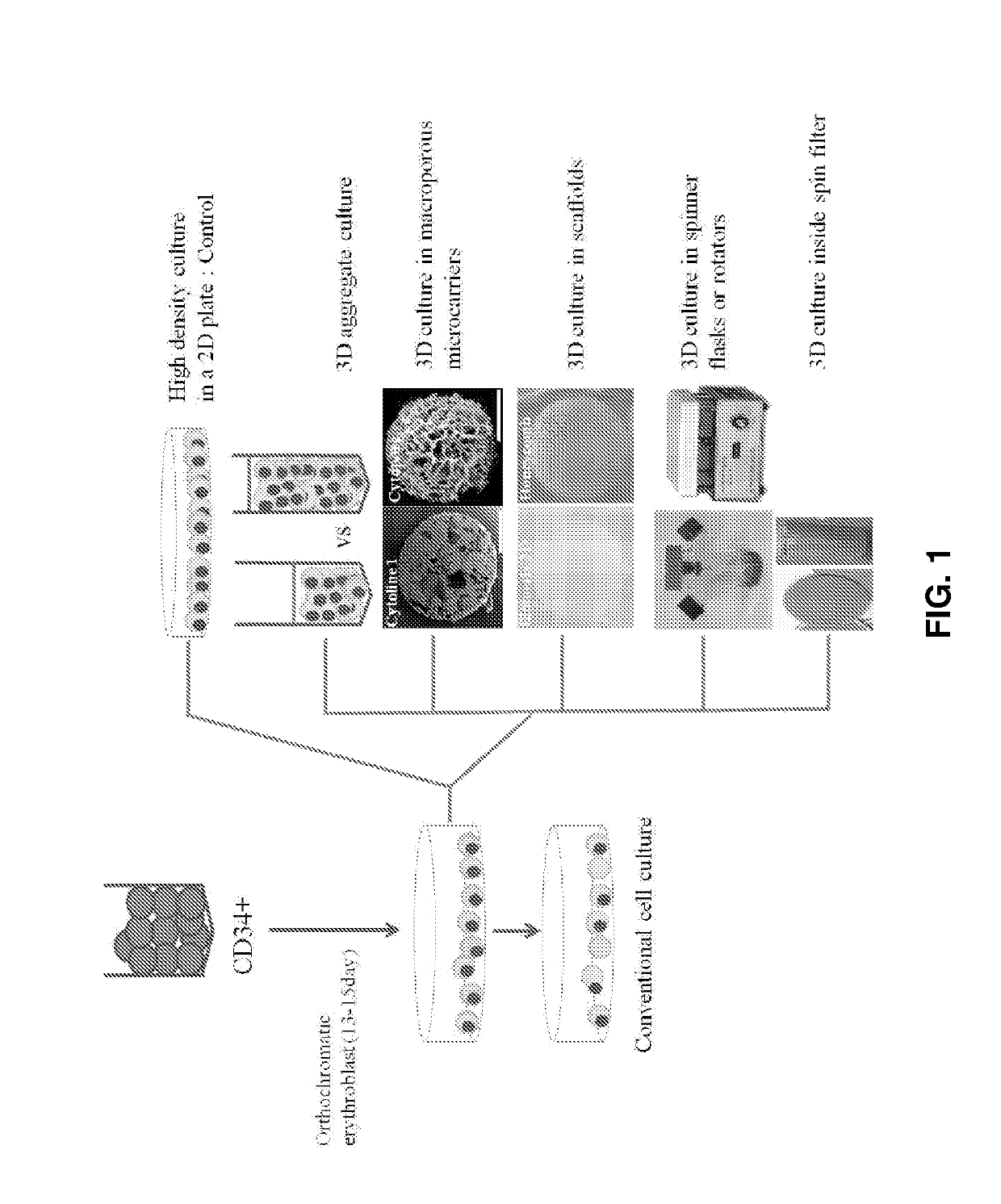In vitro expansion of erythroid cells
a technology of erythroid cells and erythrocytes, which is applied in the field of in vitro expansion of erythroid cells, can solve the problems of increasing the amount of blood preparations used, difficulty in surgery and patient treatment, and shortage of transfusable blood supply, so as to facilitate the expansion of the cell culture scale and improve the in vitro productivity of erythrocytes
- Summary
- Abstract
- Description
- Claims
- Application Information
AI Technical Summary
Benefits of technology
Problems solved by technology
Method used
Image
Examples
example 1
Cell Culture and Enumeration
[0061]CD34+ cells were isolated from the cord blood of healthy donors by using the immunomagnetic microbead selection method and EasySep CD34 isolation kit (StemCell Technologies). Some of the CD34+ cells were used for culture immediately after isolation or were frozen and stored until use. The cells were cultured under stroma- and serum-free conditions for 17 days [3, 4].
[0062]Several cytokines were added to induce the CD34+ cells to differentiate and proliferate. From day 0 to day 7, the cells were cultured in media supplemented with 10 μM hydrocortisone (Sigma), 100 ng / ml stem cell factor (SCF; R&D Systems), 10 ng / ml interleukin (IL)-3 (R&D Systems), and 6 IU / ml erythropoietin (EPO; Calbiochem). From day 7 to day 13, basophilic erythroblasts were cultured in media supplemented with 50 ng / ml SCF, 10 ng / ml IL-3, and 3 IU / ml EPO. From day 13 to day 17, 2 IU / ml EPO was added [3, 4]. On day 17, when the proportions of polychromatic erythroblasts and orthoch...
example 2
Imaging of Erythroid Cells
[0064]Cells were plated on a slide using a cell centrifuge (Cellspin, Hanil Science Industrial) and subsequent Wright-Giemsa staining (Sigma-Aldrich). The stained cells were analyzed for maturation stage, myelodysplasia, and cell integrity.
example 3
2D Plate Culture and 3D Packed Cell Culture
[0065]On days 15-17 of culture, the erythroid cells (polychromatic / orthochromatic erythroblasts) at the terminal maturation stage were divided and cultured under the conditions shown in FIG. 1. The control cells were cultured at a density of 1×106 cells / mL in a 6-well 2D plate. In the experimental groups, the cells were allowed to be packed at a density of 2×107 cells / mL in tubes and cultured in a state in which the tubes stood upright. Basal media used in the control and the experimental groups were supplemented with 5% plasma-derived serum [5]. After culture for 24 and 48 h, the cell numbers and viabilities were determined and the maturation stages of cells were confirmed using Wright-Giemsa staining.
PUM
| Property | Measurement | Unit |
|---|---|---|
| size distribution | aaaaa | aaaaa |
| size | aaaaa | aaaaa |
| volume | aaaaa | aaaaa |
Abstract
Description
Claims
Application Information
 Login to View More
Login to View More - R&D
- Intellectual Property
- Life Sciences
- Materials
- Tech Scout
- Unparalleled Data Quality
- Higher Quality Content
- 60% Fewer Hallucinations
Browse by: Latest US Patents, China's latest patents, Technical Efficacy Thesaurus, Application Domain, Technology Topic, Popular Technical Reports.
© 2025 PatSnap. All rights reserved.Legal|Privacy policy|Modern Slavery Act Transparency Statement|Sitemap|About US| Contact US: help@patsnap.com



